This is a male goldfinch.
It was one of the birds that was humanely caught and banded at
Warner Nature Center.
(Taken on June 9, 2007.)
Some of the things I shared with Sophia and Olivia that were in the Handbook of Nature Study include:
=> The goldfinch is a small bird that is fond of the seeds of wild grass, especially thistle. For this reason, goldfinches love weedy fields, open woodlands, thickets, orchards, and roadsides, especially if they contain patches of sunflowers and thistle.
=> In summer, the male has bright yellow plumage with a little black cap. He also has a black tail and wings with white-tipped coverts and primaries.
=> The head and back of the female are brown and the under parts yellowish white with wings and tail resembling those of the male except that they are not so vividly black.
=> The song of the goldfinch is exquisite. He sings the entire time his feathers are bright yellow.
=> The flight is beautiful being in an up and down motion - like waves.
=> Since goldfinches like grass seeds, only a few stay in Minnesota during the winter.
=> The goldfinch nest is a mass of fluffiness, using thistledown as the "mattress."
=> The nest is found in a bush or tree, generally 4-6 feet from the ground...but never more than 30 feet from the ground. It is generally built in August.
=> There are 4-6 eggs in a nest that are bluish-white in color.
=> Goldfinches look a lot like canaries in form, song, color, and habits. Because of these similarities, they are often called wild canaries.
*~*~*~*~*~*~*~*
On Wild Birds Forever, there were some tips for attracting goldfinches to one's yard:
=> Thistle or Nyjer seed is goldfinches' preferred food. It is best to provide thistle in specially-designed thistle/finch feeders. Store thistle seed in a cool area or refrigerator to preserve it.
We have three finch feeders around the front and back yards.
By far, the most popular one is the bag feeder that is filled with food specifically for finches.
Both the male and female goldfinches lose their coloring during the winter.
The male's feathers turn a vivid yellow during the summer.
The female's feathers remain a dull gold color throughout the year.
(Taken on February 13, 2010.)
=> Hang a thistle feeder at least 15 feet from other feeders and water sources. Hang it 4-5 feet in the air in a area that has a lot of brush if possible.
=> Goldfinches nest later in the season than most species. This is when their favorite food, thistle seeds, ripen.
=> The females line their nests with thistle down. They like to build their nests and mate from June through August.
=> Goldfinches like to nest in forked branches up to 30 feet high, usually near water. Females often return to the same site. The female builds a small bowl-shaped, tightly woven nest with grass and lines it with plant down.
=> A source of water is important. Goldfinches love to bathe. Offer water in a bird bath, with a dripper or mister.
The bird bath and hummingbird feeder.
This is a rare moment where it is quiet and
no birds are using either the feeder or bird bath.
(Taken on May 27, 2012.)
=> Plant thistle, sunflowers, coreopsis, dandelions, birch, hornbeam, cosmos, service berry, sweet gum, mulberry, hemlock, zinnias, elm, and alder as garden food plants.
This is one of many dandelions that grow here.
(Taken on May 25, 2011.)
Although we don't see meadowlarks like we do the goldfinches, they nonetheless are good to know about since they do live in Minnesota.
=> The meadowlark is often confused with the flicker. The two are approximately of the same size and color. Each has a black crescent or locket on the breast, and each shows the "white feather" during flight. The latter is the chief distinguishing characteristic: the outer tail feathers of the meadowlark are white while the flicker has only a single patch of white on the rump.
=> The flight of the lark and flicker also differ. The lark lifts itself up by several sharp movements and then flies smoothly over its course. In contrast, the flicker makes continuous up-and-down movements while it flies.
=> The colors of the meadowlark are mostly brown and yellow, with the black locket on its breast.
=> The nest is built in a depression in the ground near a tuft of grass. It is constructed of coarse grass and sticks and lined with finer grass. There is a dome of grass blades woven above the nest, and often a long, covered vestibule leading to the nest. The vestibule is protection from hawks and crows.
=> The eggs are laid about the last of May and are usually from 5-7 in number. They are white, speckled with brown and purple.
We must have had a meadowlark at the farm because
these eggs were found in the back garden when I was weeding.
(Taken on May 30, 2012.)
=> Meadowlarks like to eat what we consider pests: insects like grasshoppers, cutworms, army worms, wireworms, and weevils. It also eats some weed seeds.
Bird Watching
We filled the feeder nearest the window where we do the majority of homeschooling. Throughout the morning and early afternoon we watched as a variety of birds visited the feeder: blue jays, red-bellied woodpeckers, dark-eyed juncos, black-capped chickadees, cardinals, nuthatches, and house finches.
Not one goldfinch visited the feeder. Although they don't prefer the feeder that we were watching, they nonetheless have, in the past, visited it.
We were surprised that we didn't see one goldfinch during this entire time. Perhaps they were visiting the other feeders at the farm or the majority now have migrated to warmer climates for the winter. Hopefully we'll see some goldfinches soon. They are such a pretty bird - even in the late-fall and winter when their feathers are duller than the brighter colors we see during the summer.
Follow Up Activity
Both the girls did an entry in their nature journals about goldfinches.
Pages from Sophia's and Olivia's nature journals.
They each use a 9"x12" sketch pad for their own journal.
Looking at Past Pictures
We have quite a few goldfinches that have made their home at the farm. A few years ago in June 2009, there were three goldfinches that frequently would visit the feeder by the dining room. In the picture below, there are two males and a female goldfinch.
A male and female goldfinch on the metal holder.
A male goldfinch is eating on the feeder below.
(Taken on June 7, 2009.)
In the photo below, the male goldfinch either sat by the window on weeds or sticks, or grasped the edge of the window and peered inside.
Eenie is intently watching the male goldfinch
(Taken on June 21, 2011.)
The goldfinch did this for several days, and then stopped. He ended up staying during the day for a very long time; and it was great to be able to observe him so closely.

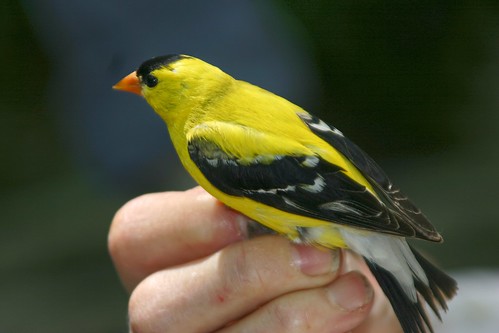
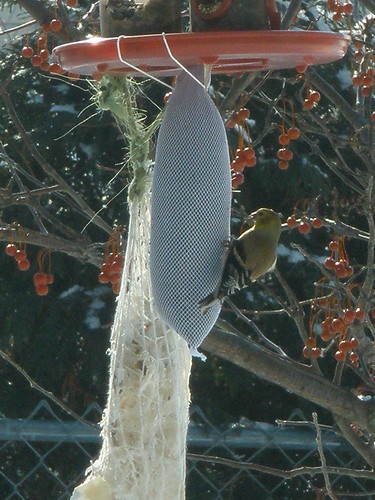
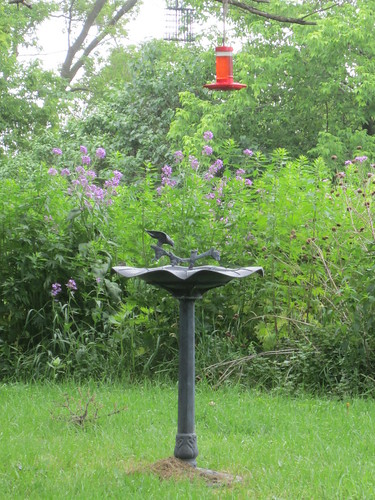
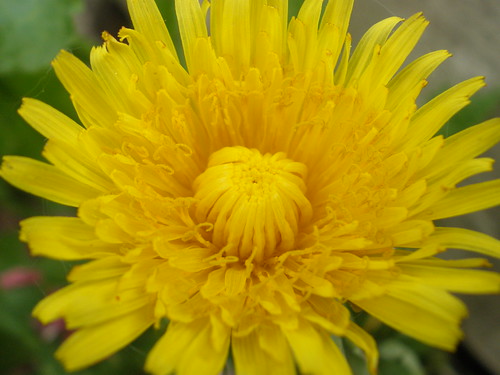
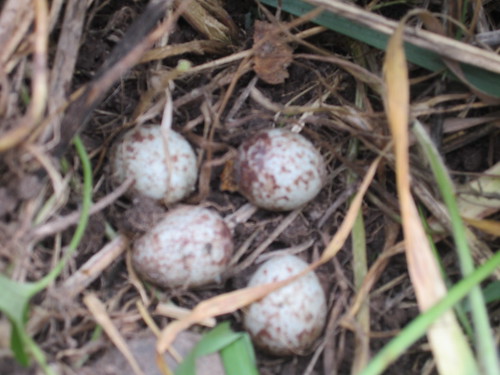
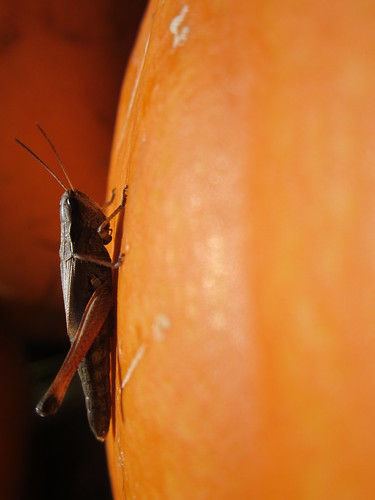


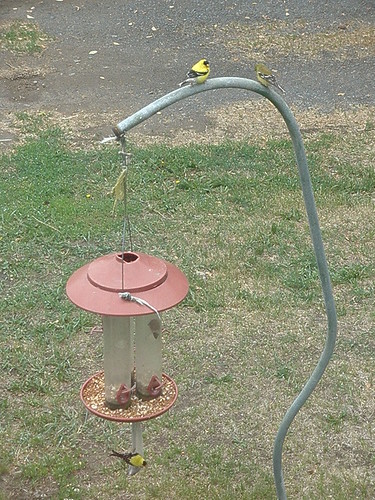
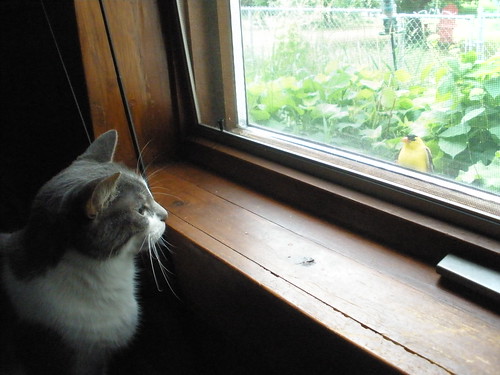

5 comments:
That grasshopper picture is awesome
Wow! Very informative post! I always learn something (okay, a lot of things) when I read your posts!
Our goldfinches never come to our feeder. They are always seen on the sunflowers, in the thistles, on the sweet gum or birch trees, and also just recently I caught them in the dried up coneflowers.
I have yet to see one in our birdbath either....never thought about it until now. I wonder if they use the bath but we just don't see them.
Thanks for the informative entry on goldfinches. :)
We see lots of Goldfinches in Maine, too. They do stay in the winter, and before and during the early stages of snowstorms we see flocks of them at our feeder. They do visit our sunflower feeder! I think they're such a cute bird I must add a thistle feeder for them.
Thanks for the great information and photos.
That's a whole bunch of nature study! We love goldfinches. I'd never had them until several years ago, and now they are all over our yard certain times of the year. I just love them!
Post a Comment